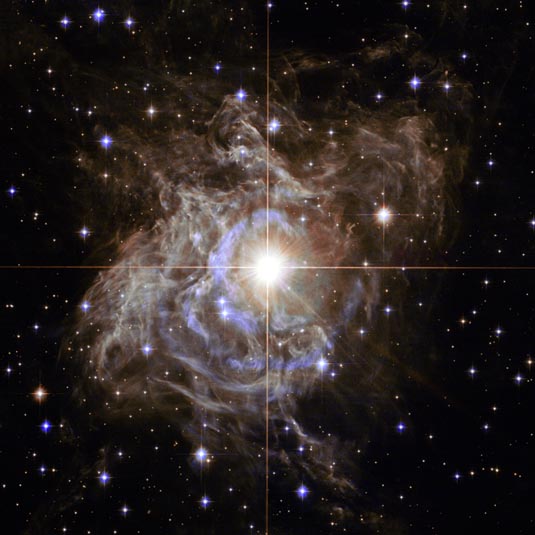
Create Holiday Light Show
Description: Cepheid Variable
Position (J2000): RA 08hr 13m 04.22s Dec. -34° 34' 42.7"
Constellation: Puppis
Distance: 6,500 light-years (2,000 parsecs)
Instrument: ACS/WFC
Exposure Date(s): March 26, 2010
Exposure Time: 35 minutes
Image Credit: NASA, ESA & the Hubble Heritage Team (STScI/AURA)-ESA/Hubble Collaboration
Release Date: December 17, 2013
ABOUT THIS IMAGE:
This festive NASA Hubble Space Telescope image resembles a holiday wreath made of sparkling lights. The bright southern hemisphere star RS Puppis, at the center of the image, is swaddled in a gossamer cocoon of reflective dust illuminated by the glittering star. The super star is ten times more massive than our Sun and 200 times larger.
RS Puppis rhythmically brightens and dims over a six-week cycle. It is one of the most luminous in the class of so-called Cepheid variable stars. Its average intrinsic brightness is 15,000 times greater than our Sun's luminosity.
The nebula flickers in brightness as pulses of light from the Cepheid propagate outwards. Hubble took a series of photos of light flashes rippling across the nebula in a phenomenon known as a "light echo." Even though light travels through space fast enough to span the gap between Earth and the Moon in a little over a second, the nebula is so large that reflected light can actually be photographed traversing the nebula.
By
observing the fluctuation of light in RS Puppis itself, as well as recording
the faint reflections of light pulses moving across the nebula, astronomers
are able to measure these light echoes and pin down a very accurate distance.
The distance to RS Puppis has been narrowed down to 6,500 light-years
(with a margin of error of only one percent).
From the ESA press release:
The NASA/ESA Hubble Space Telescope has observed the variable star RS Puppis over a period of five weeks, showing the star growing brighter and dimmer as it pulsates. These pulsations have created a stunning example of a phenomenon known as a light echo, where light appears to reverberate through the murky environment around the star.
For most of its life, a star is pretty stable, slowly consuming the fuel at its core to keep it shining brightly.
However, once most of the hydrogen that stars use as fuel has been consumed, some stars evolve into very different beasts - pulsating stars. They become unstable, expanding and shrinking over a number of days or weeks and growing brighter and dimmer as they do so.
A new and spectacular Hubble image shows RS Puppis, a type of variable star known as a Cepheid variable [1]. As variable stars go, Cepheids have comparatively long periods. RS Puppis, for example, varies in brightness by almost a factor of five every 40 or so days.
RS Puppis is unusual as it is shrouded by a nebula - thick, dark clouds of gas and dust. Hubble observed this star and its murky environment over a period of five weeks in 2010, capturing snapshots at different stages in its cycle and enabling scientists to create a time-lapse video of this ethereal object.
The apparent motion shown in these Hubble observations is an example of a phenomenon known as a light echo [2]. The dusty environment around RS Puppis enables this effect to be shown with stunning clarity. As the star expands and brightens, we see some of the light after it is reflected from progressively more distant shells of dust and gas surrounding the star, creating the illusion of gas moving outwards. This reflected light has further to travel, and so arrives at the Earth after light that travels straight from star to telescope [3]. This is analogous to sound bouncing off surrounding objects, causing the listener to hear an audible echo.
While
this effect is certainly striking in itself, there is another important
scientific reason to observe Cepheids like RS Puppis. The period of their
pulsations is known to be directly connected to their intrinsic brightness,
a property that allows astronomers to use them as cosmic distance markers.
A few years ago, astronomers used the light echo around RS Puppis to measure
its distance from us, obtaining the most accurate measurement of a Cepheid's
distance. Studying stars like RS Puppis helps us to measure and understand
the vast scale of the Universe.
Notes
[1] RS Puppis is over ten times more massive than our Sun, and around 15 000 times more luminous. It lies around 6500 light-years away from us.
[2] This light echo enabled astronomers to measure the distance to RS Puppis very accurately back in 2008. This measurement is the most accurate ever calculated for a Cepheid.
[3]
This effect can make it appear that this propagation of light is happening
at speeds greater than the speed of light, but this is just an illusion.